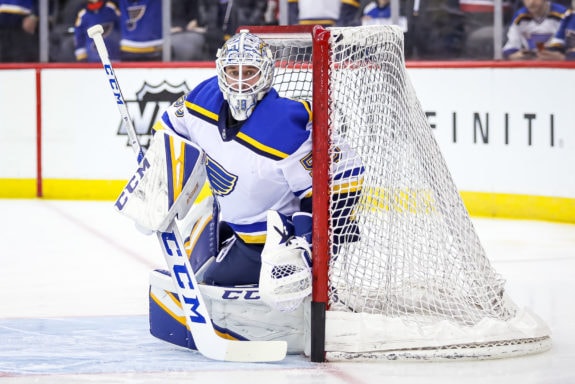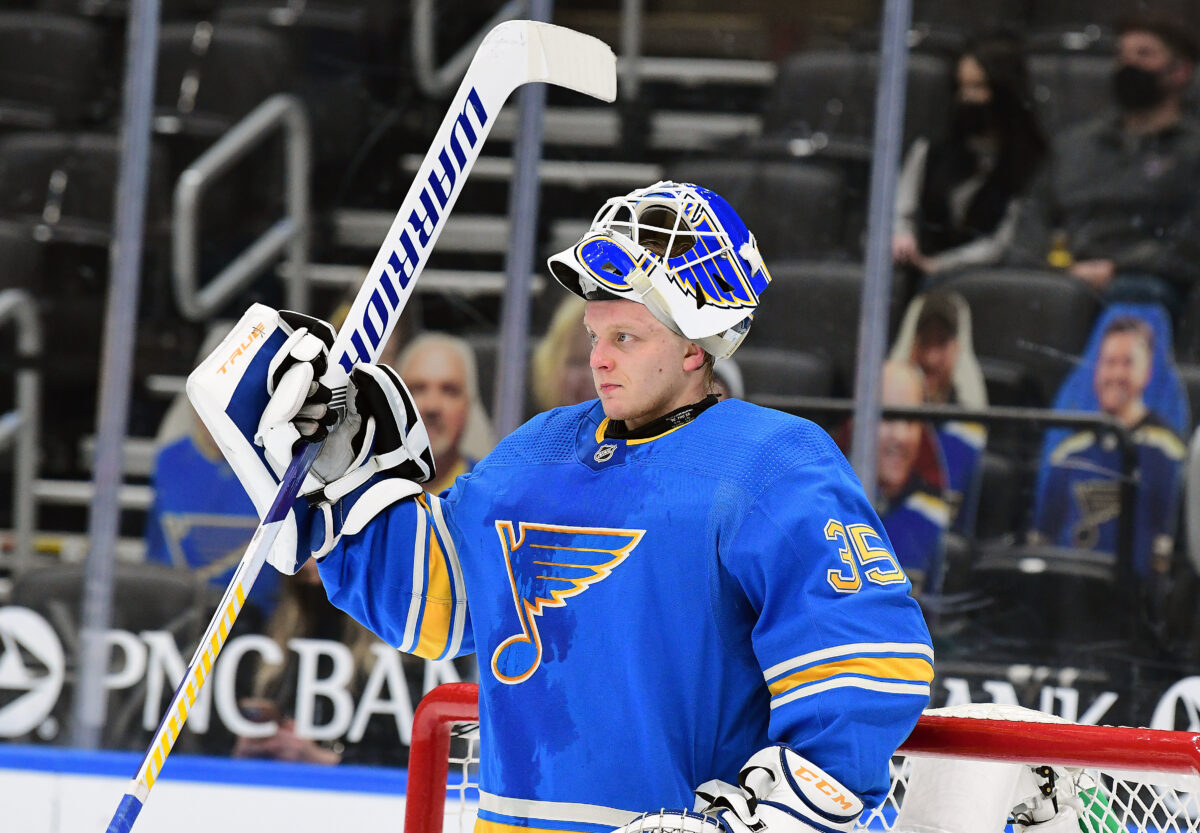On Wednesday, the St. Louis Blues locked down a solid goaltending prospect, signing 2020 sixth-round pick Will Cranley to an entry-level contract (ELC) that begins next season. The 20-year-old is still a long way from the NHL, but he is yet another bright piece of their goaltending pipeline. And his signing is a convenient excuse to take a deeper look at the Blues’ future in net.
Related: The Top Ten NHL Goalie Prospects
Though there has been some goaltending controversy in St. Louis this season, the Blues have possibly the healthiest pipeline top-to-bottom that they’ve ever had. In this article, we’ll look at each goalie individually. Despite his contributions this season, we will skip over Charlie Lindgren, because the 28-year-old journeyman likely doesn’t fit into the long-term future plans of the team. But even without him, the future is very bright.
Jordan Binnington
The Blues’ inked starting goaltender Jordan Binnington to a six-year, $36 million contract last season. This season, concern grew rapidly about whether that contract would quickly become an albatross for the team. Binnington has had a rough season, and his backup, whom we’ll discuss in a moment, has been extraordinary. But the recent returns for the starter have been much more promising.

In his last two games, Binnington has allowed just one goal on 56 shots against, winning two games on the road and pitching a shutout against the archrival Chicago Blackhawks. Of course, two good games do not erase a rough season. But the overall numbers are misleading. Removing the three-game skid against the Toronto Maple Leafs, Calgary Flames, and New Jersey Devils, in which Binnington allowed 18 goals, his numbers improve drastically. In the other 23 games of the season, he has a 13-7-3 record with a .915 save percentage (SV%) and a 2.65 goals-against average. Those aren’t world-beating numbers, but they certainly don’t paint the picture of a career that is in jeopardy.
Binnington’s game relies on confidence, and now that he has some, he could be a dangerous threat in the run towards the playoffs. A similar series of events played out last season: he struggled in late winter, took a break to regain his swagger, and became a weapon in the final playoff push. An elite goaltender cannot have periods each season where he is unplayable, but he’s already won the team one Stanley Cup, and they are locked into him for the long term. If he can find consistency, he can reestablish himself as one of the top goalies in the NHL.
Ville Husso
The only question the Blues have about Ville Husso right now is whether they can afford to keep him. After a rocky first season in the NHL, Husso has now been one of the league’s top goaltenders through 20 games, and he has largely replaced Binnington as the starter in recent weeks. The only problem? He’s an unrestricted free agent after the season, which puts the Blues in a difficult position.

There is certainly trade interest in Husso, especially from the Edmonton Oilers. Their veteran goaltenders Mike Smith and Mikko Koskinen have not measured up, and it seems to be their major obstacle to being a clear playoff contender. But if the Blues trade Husso, they distinctly weaken their own ability to contend in the playoffs, even if Binnington truly has returned to form. Alternatively, if he finishes the season in St. Louis, he’ll be due a major pay raise. If he demands something in the $3-$4 million range, an extension would put the Blues near the top in salary cap commitment to goaltending. When fully healthy, the Montreal Canadiens spend over $13.3 million on the combo of Carey Price and Jake Allen, but only five other teams spend over $8 million total on their tandem.
Technically, having a goaltender with a .931 SV% and a 2.13 GAA is a good problem to have. But for general manager Doug Armstrong, it’s certainly a problem. Husso has been the Blues’ goalie of the future for a long time, but Binnington surpassed him in the legendary Stanley Cup run. Now, they’re head to head, and the prospect of keeping both for a combined $10 million is unrealistic. It’s a tough decision, but one the Blues need to make quickly.
Joel Hofer
The Blues’ drafted Joel Hofer in the fourth round of the 2018 Draft, but he truly rose to prominence after his standout performance at the 2020 World Junior Championship. There, he delivered a gold-medal winning performance, rescuing Team Canada after an embarrassing start. Since then, he’s had stops and starts in the American Hockey League (AHL), but he did collect his first NHL win this season when he had to start in a pinch. His AHL numbers are lackluster, but he’s just 21. With his junior pedigree and his size, Hofer remains the brightest star in the pipeline and the most likely to someday take over as the number one in St. Louis.
Colten Ellis
The year after they selected Hofer, the Blues continued to supplement their goaltending depth by selecting Colten Ellis in the third round. The season prior, he had helped his Rimouski Océanic to the third round of the QMJHL playoffs (alongside future first overall pick Alexis Lafrenière). He had another good season with Rimouski before joining the Charlottetown Islanders for his final junior season. There, he looked like a budding star, carrying a 1.78 GAA and a .926 SV% in 24 games, despite the high scoring output usually associated with the QMJHL. In fact, Ellis graduated as one of the most accomplished QMJHL goalies of all time, breaking the league’s shutout record and becoming one of just 17 goals with 100-plus wins in the league.
Will Cranley
To circle back to the Blues’ newest signee, Cranley joined the organization in the sixth round of the 2020 Draft, coming over from the Ottawa 67s. The Peterborough, ON native, has had really rough numbers this season in the OHL, but the 67s are in a rebuilding phase. He has the size, at 6-foot-4, 185 pounds. He still has a lot of developing to do, but the raw potential is there. Clearly, the Blues see something in him given the new contract. He will likely play at the ECHL level next season.
Vadim Zherenko
The Blues weren’t done with goalies after Ellis in 2019 because late in the seventh round, they took the relatively-unknown, raw goaltender Vadim Zherenko out of Russia. While he still doesn’t get much coverage from prospect analysts, looking solely at numbers, he seems to have the makings of a future Russian goalkeeping superstar.
In Russia’s MHL, the developmental league beneath the KHL, Zherenko led Dynamo Moskva through last season’s playoffs with a 10-1-2 record, a 1.56 GAA, and a .939 SV% en route to taking the honors as playoff MVP. That was the culmination of a brilliant career at two levels of Russian hockey. Now, at just 20 (approaching 21 later this month), he’s a starter for Ilves in Liiga, the Finnish adult league. His numbers have dropped, with just a .902 SV% and a 2.64 GAA. Compared to his numbers in the MHL and the VHL, those levels look paltry. But keeping in mind that he’s a 20-year-old rookie in an adult league, one of the best leagues outside the NHL, and a league that regularly pumps out NHL-caliber goaltenders, his presence there is a sign that this seventh-round pick could become a surprise star for the Blues.
Organizational Depth
The Blues have quality goaltending from top-to-bottom in their organization. Every goalie in this article has at least a shot at becoming an NHL goalie, which is rare for goalie prospects. But the journey to the top level as a netminder is longer and more arduous than for any other position. It’s difficult to project which goaltenders actually will turn into NHL options. But that makes organizational depth that much more important. Quantity is as important as quality with goalie prospects. You only need one to become a top-level NHL option to be set at the position for many years.